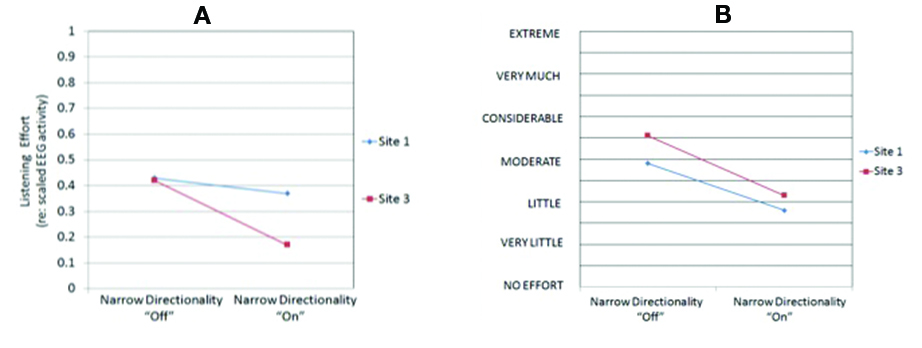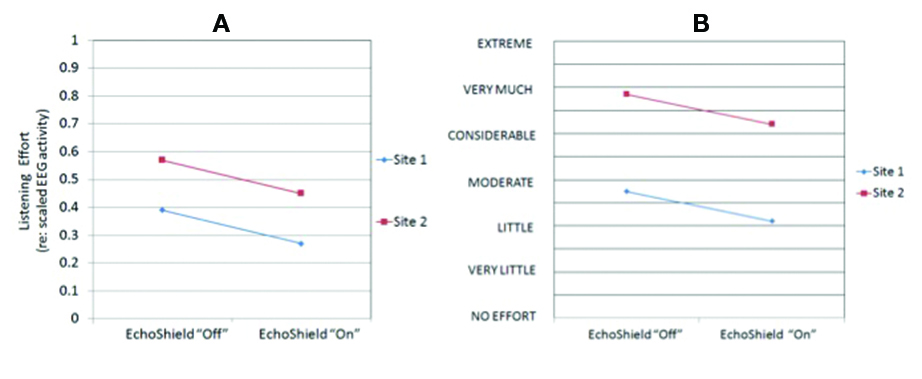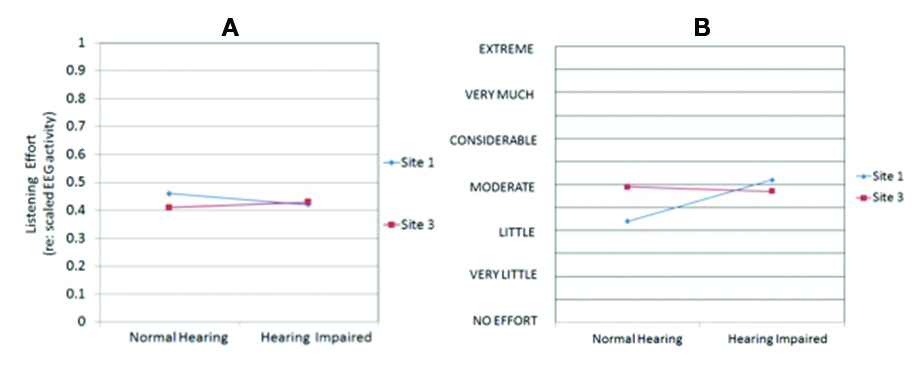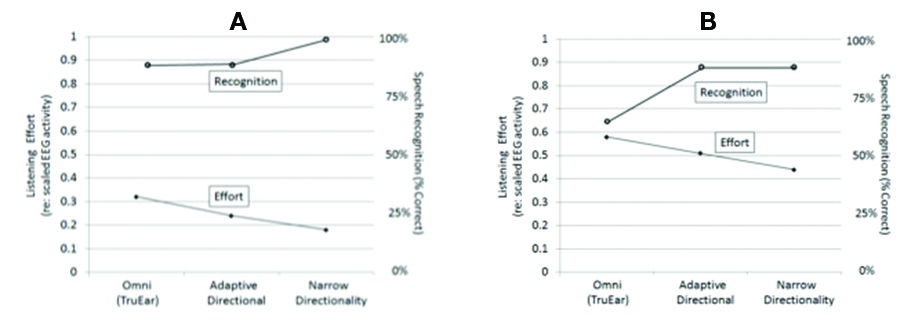Multi-center Evidence of Reduced Listening Effort Using New Hearing Aid Technology
Veronika Littmann, PhD; Yu-Hsiang Wu, PhD; Matthias Froehlich, PhD, and Thomas Powers, PhD
Hearing Review, February 14, 2017
Reused with permission from Hearing Review. All right reserved.
In early 2016, Signia launched the new primax platform. As with all new Signia hearing aid technology, the features and algorithms of the product were designed to provide excellent sound quality, appropriate loudness, listening comfort, and to optimize speech understanding, particularly in background noise.
Regarding understanding in background noise, the binaural beamforming strategy of the binax product, which can provide Narrow Directionality, was carried over to the primax (see Kamkar-Parsi1 for a review of this processing). Research with this technology at two independent research sites has shown that it provides a 5 dB signal-to-noise (SNR) advantage (~8-12% improvement/dB) over Signia TruEar (omnidirectional with pinna compensation), and when hearing-impaired individuals are fitted with these instruments, speech recognition significantly exceeds that of individuals with normal hearing.2,3 Further study of this beamforming technology at Vanderbilt University revealed that the large SNR benefit observed in the mini-BTE RIC style also was present with small custom products, and with individuals with severe hearing impairments.4,5
When developing the primax platform, we wanted to build on the strengths of this well-established beamforming algorithm. However, we also wished to examine other factors that increase benefit and satisfaction with hearing aids, such as the reduction of listening effort.
In general, we can think of listening effort during speech tasks as the amount of cognitive resources that are being allocated to process and understand speech. As the task becomes more effortful, more resources are needed. It’s possible that these are resources which could (or should) be used for other tasks. Greater effort over extended time— a day struggling to understand speech in background noise—can lead to listening fatigue. Therefore, the goal of hearing aid amplification is not only to optimize speech understanding, but to do so in a manner that minimizes patient effort.
Initial research in this area with the primax product were encouraging. For example, Littmann et al6 and Herbig and Froehlich7 reported that several features of primax provided reduced listening effort when activated. The greatest reduction in effort was observed for the binaural beamforming Narrow Directionality. However, the new primax reverberation-reduction algorithm, referred to as EchoShield, also showed a significant effect.
EchoShield operates on the level difference between the direct sound and the reflected sounds, the latter of which is softer. Reverberation is typically only noticeable in quieter situations that are classified by the hearing aid as “speech in quiet,” because if a reverberant room is not quiet, the reverberation is masked by noise. Therefore, directional microphones are typically not automatically activated in situations where reverberation is noticeable. EchoShield, however, utilizes a combination of different signal processing schemes, including the use of directional characteristics to differentiate speech coming from the front while reducing the reverberations coming from other azimuths.
The research reported by Littmann et al6 and Herbig and Froehlich7 used two different measures of listening effort. The first was the traditional subjective measure by the participant, rating effort on a 13 point scale with 7 anchors, ranging from “no effort” to “extreme effort.” The second method for assessing listening effort was objective, based on the electroencephalogram (EEG) recordings of the electrical events produced by the brain during a speech recognition task; the EEG sample was extracted to precisely coincide with the given task. To obtain a measure of how much attention the listener invests to solve a given task, the angular entropy (phase distribution) of the EEG is examined. For a non-effortful listening environment, the phase is more uniformly distributed on the unit circle than for a demanding condition, where there is a specific focus and the phase is more clustered. For meaningful interpretation of the EEG activity, mathematical calculations of phase vector were conducted (the Rayleigh Test), which then resulted in scaled values of the objective results from 0.0 (no effort) to 1.0 (extreme effort). (For more information regarding the use of this EEG procedure to assess listening effort see Shafer et al.8)
Since these early research efforts, the impact that the features of the Signia primax hearing aid have on listening effort has been studied at three leading international research sites, using the behavioral and EEG objective assessment tools just described:
- Site 1: Hearing and Aging Research Laboratory (HARL), University of Iowa, Iowa City, IA, USA.
- Site 2: National Centre for Audiology, University of Western Ontario, London, Canada.
- Site 3: National Acoustic Laboratories (NAL), Sydney, Australia.
The number of participants, speech material used, the SNRs applied to establish baseline, and the primax features examined varied somewhat from site to site, but all sites used the same hearing instruments, objective EEG analysis, and subjective self-assessment judgments of effort. In this paper, we present a review of the preliminary findings from the three different sites.
Narrow Directionality Benefit
As discussed, a feature of primax is Narrow Directionality, achieved through binaural beamforming. This feature was assessed at both Site 1 and Site 3, and a summary of their findings is shown in Figure 1. The results from Site 1 did not show a significant effect for the objective measure, but a significant improvement was noted for the behavioral effort ratings, with effort going from “moderate” to “little effort” (Figure 1a, 37% reduction in listening effort). The results from Site 3 are very similar to that reported by Littmann et al.6Note that, for the objective measure, a large improvement (60%, p=.04) is observed, with similar benefit noted for the self-ratings (Figure 1b) which showed an average “little effort” rating when the Narrow Directionality algorithm was activated—a 40% improvement in listening effort (p=.05).

Figures 1a-b. [Click on images to enlarge.] Impact of Narrow Directionality on listening effort for: 1a) the objective EEG (mean scaled values), and 1b) the behavioral self-rating of effort (right panel; mean scaled values). Results from Site 1 and Site 3.
EchoShield Advantage
As described earlier in this article, EchoShield is a new primax algorithm designed to reduce reverberation. In theory, reduced reverberation should improve speech intelligibility and perhaps also reduce listening effort. The latter was shown to be true in the research of Littmann et al6who showed a significant 25-30% reduction in listening effort when using the objective EEG assessment.

Figure 2a-b. Impact of the EchoShield algorithm on listening effort for: 2a) the objective EEG (mean scaled values), and 2b) the behavioral self-rating of effort (mean scaled values). Results from Site 1 and Site 2.
In our present data collection, the EchoShield was evaluated at both Site 1 and Site 2. The objective data and subjective ratings are shown in Figure 2. It appears that the speech recognition task was more difficult for the participants at Site 2, as individuals at this Site reported exerting more effort when attempting to understand speech, perhaps due to the degree of reverberation of the test environment. Our interest, however, lies in the relative differences (EchoShield “On” versus “Off”) which is very similar between sites, independent of the listening effort starting points. Note that for the objective measure (Figure 2a), there is a similar improvement when EchoShield was activated (Site 1=25%; Site 2=20%). Similarly, the subjective ratings shown in Figure 2b reveal the same trend in benefit (Site 1=10%; Site 2=13%). Speech recognition also was assessed at both sites, showing an 11% improvement with the feature activated for Site 2. The speech recognition improvement was only 5% at Site 1; however, some participants experienced a ceiling effect for the Connected Sentence Test (CST) material with the EchoShield activated, which may have obscured true benefit.
Comparison to Normal-hearing Individuals
The majority of research with aided listening effort has measured the benefit of a given feature, or simply the benefit of aided versus unaided. It is reasonable to question, however, how aided listening effort findings compare to individuals with normal hearing.

Figure 3a-b. Results for the comparison of listening effort for the hearing impaired versus the normal (or near-normal) hearing participants. Mean findings shown for the objective EEG (left panel, 3a) and the subjective self-ratings (right panel, 3b).
This was studied with Signia primax at both Site 1 and Site 3. The aided listeners had the Narrow Directionality algorithm activated. The same fixed SNR was used for both groups; a pre-determined level that was found to result in performance of around 80% for the normal-hearing participants. Figure 3a shows that, for the objective listening effort measure, the results are very similar for the two sites, and there is no significant difference between the two groups of listeners.
A slightly different pattern is present for the patient’s subjective self-ratings of effort (Figure 3b). Data from Site 3 show mean ratings for both groups to be essentially identical, consistent with the objective findings. For Site 1, it appears that the hearing-impaired group rated the task as requiring slightly more effort than the normal-hearing group, although this finding was not significant (p>.05). In general, we can conclude that, when aided with Signia primax using the Narrow Directionality feature, listening effort for hearing-impaired individuals will be essentially the same as for individuals with normal or near-normal hearing for the same speech-in-noise task.
As noted, the primary focus of the research at the different research sites was listening effort, but in some cases speech recognition in background noise also was assessed. For example, Dillon and colleagues9,10 recently reported the findings for Site 3, where speech recognition was assessed for hearing-impaired participants with the Signia primax Narrow Directionality activated, and these results were compared to the performance of age-matched individuals with close-to-normal hearing. Testing was conducted at an SNR of -3.5 dB, and the results showed that, for the hearing-impaired individuals whose four-frequency PTA was 60 dB or better, aided speech recognition performance was equal to that of the normal-hearing participants (mean = 84% versus 81% for normal hearing).
Putting It All Together
Our previous research, and the series of studies reviewed here, has given us the opportunity to compare objective listening effort, subjective listening effort, and speech understanding for a large pool of participants. While some factors fall into place nicely, other findings illustrate how the issue of listening effort can be complex. This is the reason why researchers are currently investigating different methods of assessing listening effort objectively.
In our opinion, the EEG approach is the only method reflecting the direct response of the central nervous system, while other approaches (eg, pupilometry) are an indirect measure of the autonomous nervous system, and consequently measurement conditions are difficult to control. For example, with pupilometry, general arousal completely independent of listening effort would also influence the pupil dilation.

Figure 4a-b. Listening effort and speech recognition results for two different participants (left panel vs right panel), tested at the same SNR. Shown for each participant is their objective EEG effort compared to speech recognition (percent correct) for the same Signia hearing aid settings: omni (TruEar), adaptive directional, and Narrow Directionality.
As an example of the listening effort interaction, we show in Figure 4 the objective listening effort and speech recognition in background noise (percent correct) for two different participants from our Site 1 database. The two individuals have similar hearing losses and were tested at the same SNR. Note that, for Case #1 (Figure 4a), he does quite well using Signia primax in the omnidirectional mode, and his objective listening effort is that of the average listener (eg, see Figure 3). When using adaptive directional, his speech recognition performance does not improve, but he can attain this performance with less effort. With Narrow Directionality, his speech recognition performance improves, and his listening effort is reduced even more, substantially better than average.
A somewhat different pattern is observed for Case #2 (Figure 4b). Her speech recognition is much lower in the omnidirectional mode, and her objective listening effort for this condition is considerably higher than normal. When we use adaptive directional, we see a substantial improvement in both her speech recognition and her listening effort. Going from adaptive directional to Narrow Directionality did not result in an improvement in her speech understanding, but we do see a further reduction in listening effort.
In total, we would conclude that the person in Case #2 is working harder, and still not performing quite as well as the person in Case #1 for the same listening task. In both cases, however, we see that Narrow Directionality either improves speech recognition, or reduces listening effort, or both.
Summary
In recent years, research with new hearing aid technology has examined several factors associated with speech recognition. Associated listening effort is one factor that has garnered significant attention, and it has been the focus of clinical studies with the new Signia primax.
The findings have been encouraging. In this paper, we reviewed clinical studies from three leading hearing aid research centers, and show a consistent trend showing the primax features to significantly reduce listening effort. Moreover, research from one site revealed that speech recognition performance for hearing-impaired listeners (pure-tone average 35-60 dB) using the primax Narrow Directionality algorithm was equal to that of normal-hearing individuals for the same speech-in-noise task. Overall, the cumulative findings show the desired primax design goal of optimizing speech understanding while simultaneously reducing listening effort.
References
-
Kamkar-Parsi H, Fischer E, Aubreville M. New binaural strategies for enhanced hearing. Hearing Review. 2014;21(10)[Oct]:42-45.
-
Froehlich M, Freels K, Powers T. Speech recognition benefit obtained from binaural beamforming hearing aids: Comparison to omnidirectional and individuals with normal hearing. May 28, 2015. Available at: http://www.audiologyonline.com/articles/speech-recognition-benefit-obtained-from-14338
-
Powers T, Froehlich M. Clinical results with a new wireless binaural directional hearing system. Hearing Review. 2014;21(11)[Nov]:32-34. Available at: http://www.hearingreview.com/2014/10/clinical-results-new-wireless-binaural-directional-hearing-system/
-
Froehlich M, Powers T. Improving speech recognition in noise using binaural beamforming in ITC and CIC hearing aids. Hearing Review. 2014;2(12)[Dec]:22-26. Available at: http://www.hearingreview.com/2015/11/improving-speech-recognition-noise-using-binaural-beamforming-itc-cic-hearing-aids
-
Powers T, Littmann V. Benefits of binaural beamforming for individuals with severe hearing loss. Hearing Review. 2016;23(5):28-30. Available at: http://www.hearingreview.com/2016/04/benefits-binaural-beamforming-individuals-severe-hearing-loss
-
Littmann V, Froehlich M, Beilin J, Branda E, Schaefer P. Clinical studies show advanced hearing aid technology reduces listening effort. Hearing Review. 2016;23(4)[Apr]:36-38. Available at: http://www.hearingreview.com/2016/03/clinical-studies-show-advanced-hearing-aid-technology-reduces-listening-effort
-
Herbig R, Froehlich M. Reducing listening effort via primax hearing technology. June 9, 2016. Available at: http://www.audiologyonline.com/articles/reducing-listening-effort-via-primax-17275
-
Schafer PJ, Serman M, Arnold M, Corona-Strauss FI, Strauss DJ, Seidler-Fallbohmer B, Seidler H. Evaluation of an objective listening effort measure in a selective, multi-speaker listening task using different hearing aid settings. Conf Proc IEEE Eng Med Biol Soc. 2015; Aug:4647-50
-
Dillon, H. Listening in noise. Paper presented at: World Congress of Audiology; September 2016; Vancouver, BC.
-
Mejia J, Carter L, Dillon H, Littman V. Listening effort, speech intelligibility, and narrow directionality. Hearing Review. 2017;24(1):22. Available at: http://www.hearingreview.com/2017/01/listening-effort-speech-intelligibility-narrow-directionality


